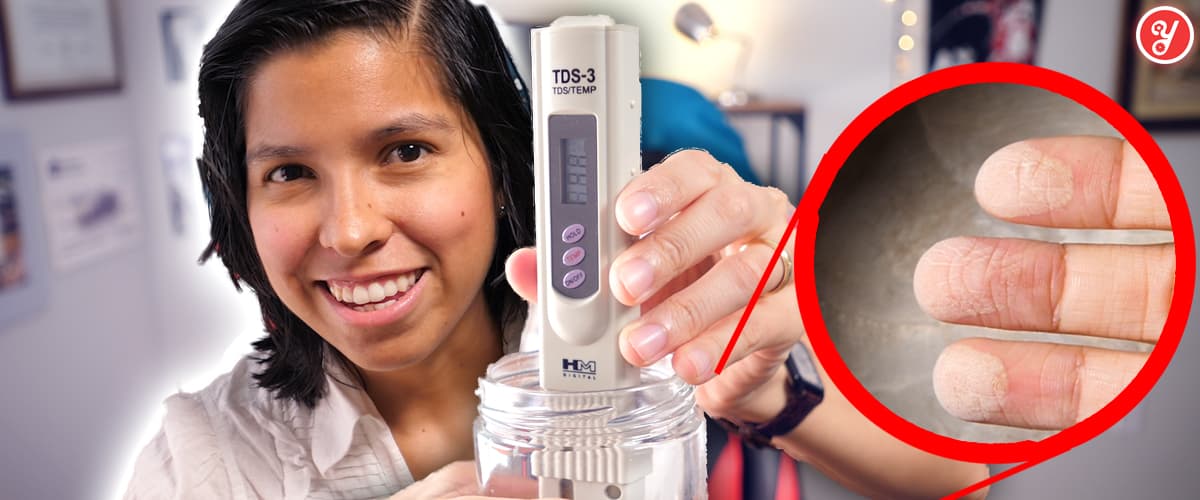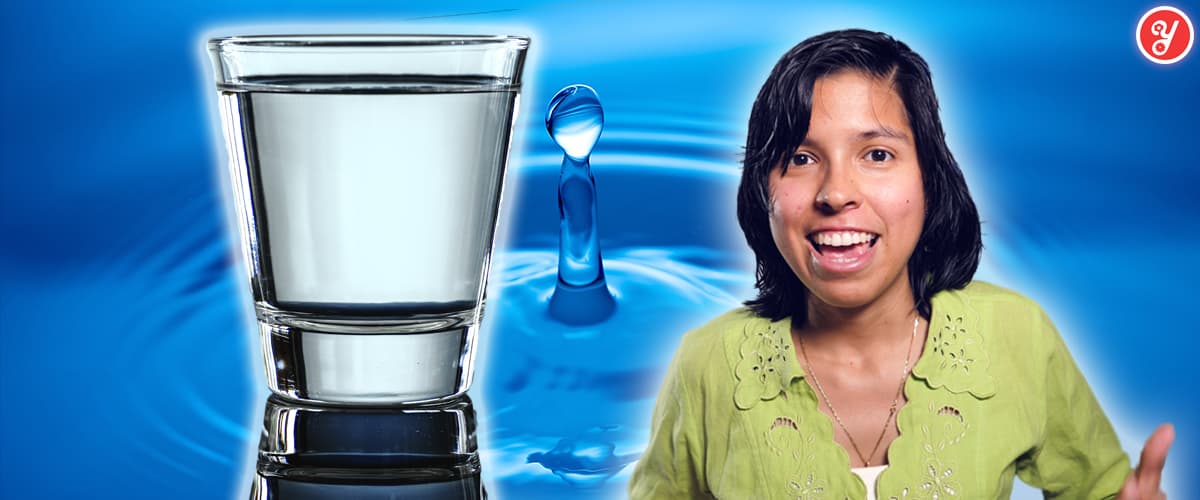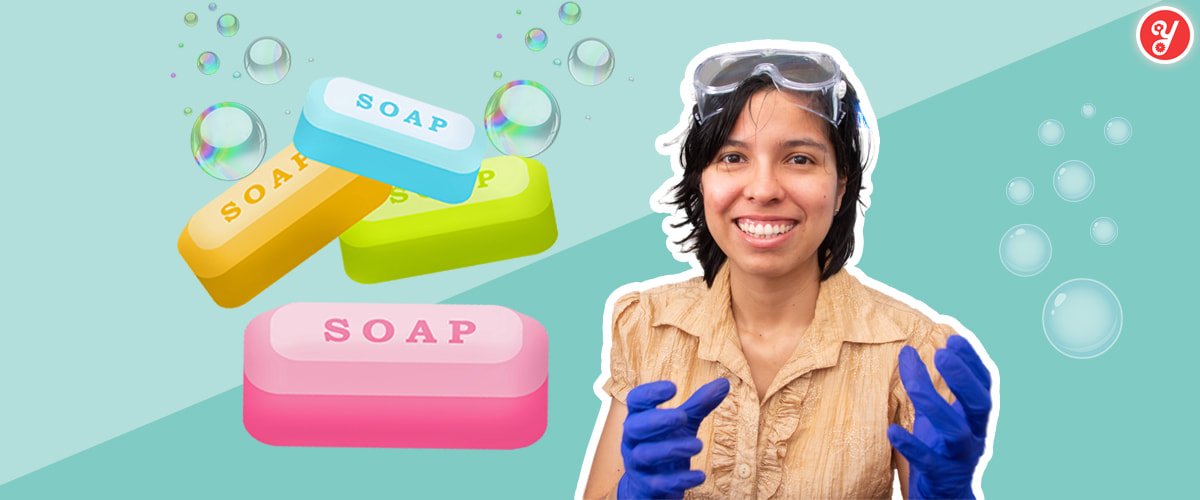Yoguely is reader-supported. When you buy through links on our site, we may earn an affiliate commission. Learn more
Is Bottled Water Is Safer Than Tap Water?
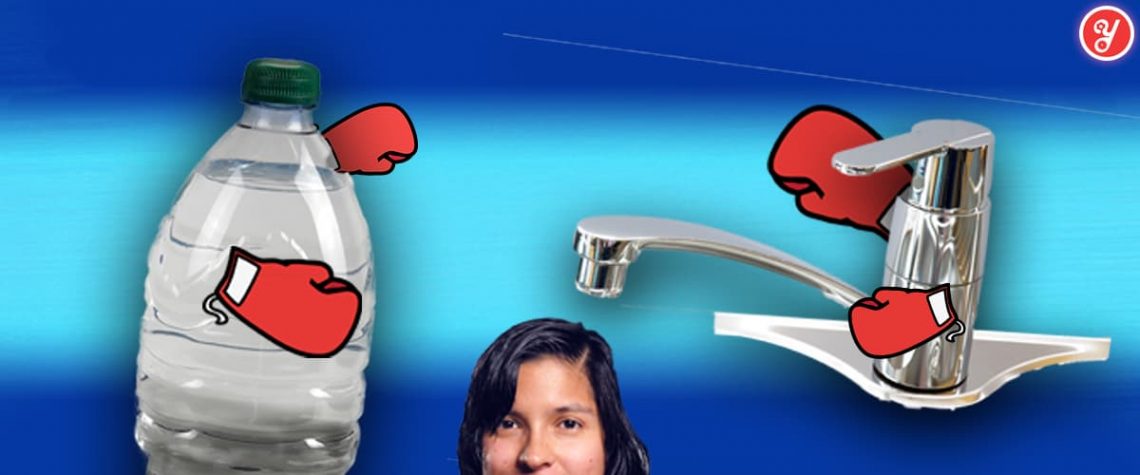
Today I’m going to show you 3 HUGE reasons why bottled water is not better than tap water.
This is the second part of my complete guide to healthy drinking water.
So, if you are wondering if bottled water is a good source of healthy drinking water in the long-term, you’ll definitely need to read this.
I’m your host Aida Yoguely. Let’s dive into it.
Is Bottled Water a Trustworthy Healthy Drinking Water Option?
Previously learned that tap water is not the optimal choice for healthy drinking water. As we’ve now realized, it needs to be much more purified.
The first place you turn to when you don’t trust your tap water is bottled water. The mentality is pay a couple more bucks and get a better-quality controlled product, right?
Ehh not really.
That extra cash your spending could be going towards prettier packaging, catchy commercials, or an old man’s yacht.
Here are three reasons why bottled water isn’t any better than tap water.
1. Bottled Water Isn’t Safer Than Tap Water.
Recall that in the US the EPA regulates our tap water. The Federal Food & Drug Administration (FDA) on the other hand regulates our bottled water .[13] The FDA is required by law to have at least an equivalent standard of quality than that of the EPA.[14]
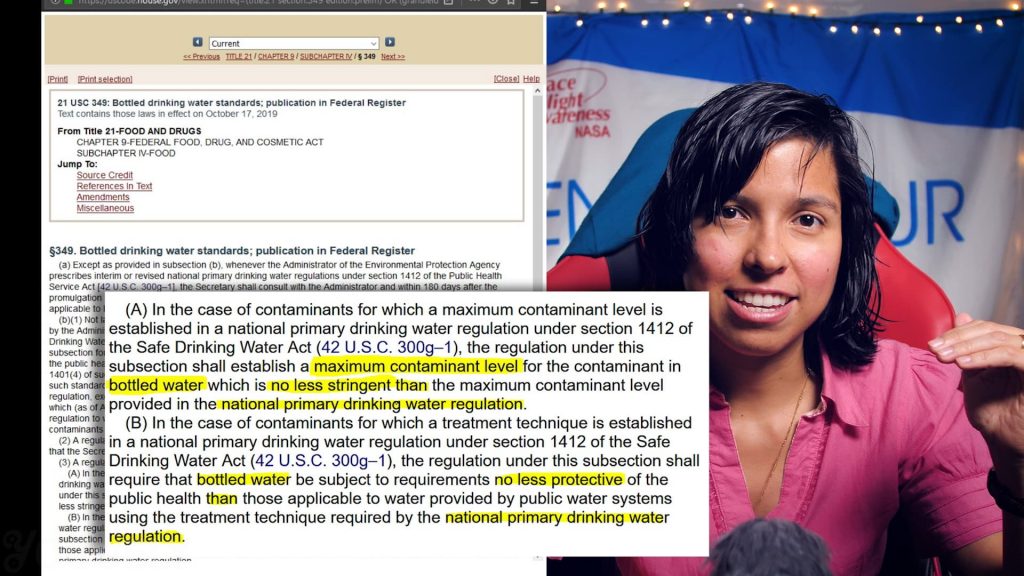
So, picture this, it is perfectly fair-game for a company to sell you straight up tap water. They literally take tap water, package it in a bottle, slap a label on it and sell it to you for 300 to 2000 times the price of tap water.[15]
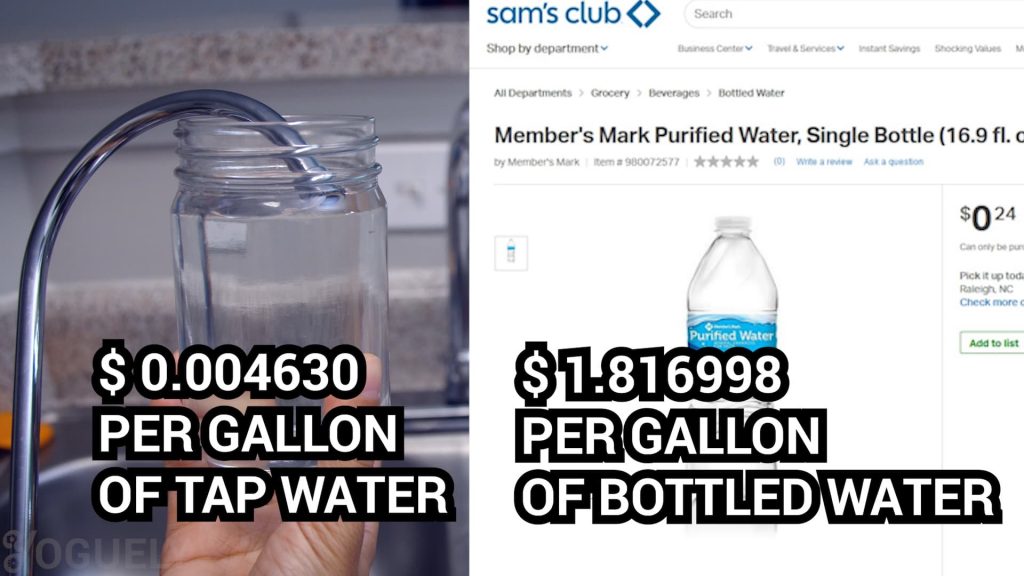
That’s right, it’s not economical to drink bottled water either.
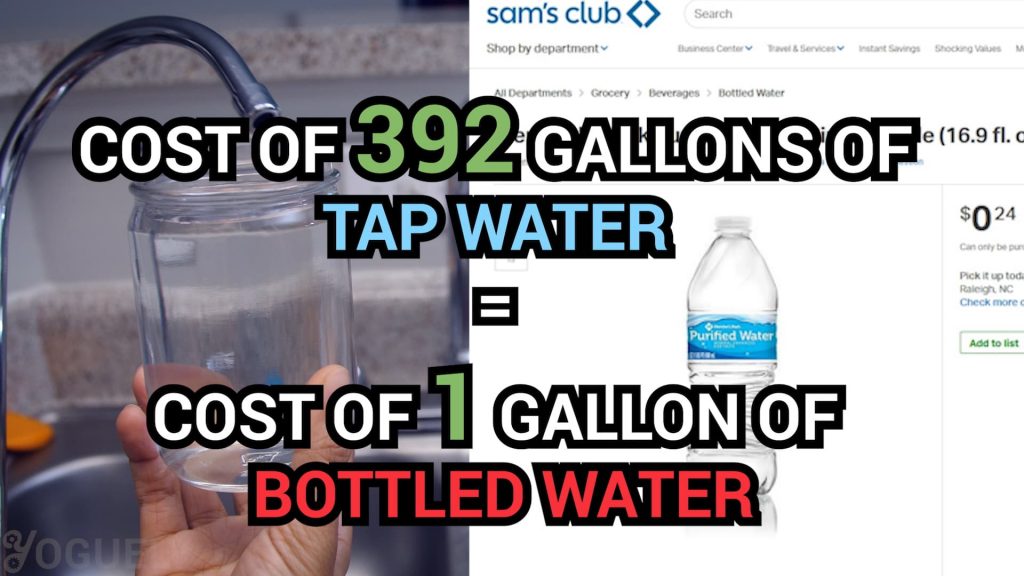
Popular Bottled Water Terms and What They Mean
You may have seen water bottles labeled as Spring Water, don’t let that catch you off guard. The term spring water is simply water from an underground aquifer, collected as it flows to the surface.
Oh! And it may or may not be treated.[16]
To identify which is the best spring water to drink, you’ll need to know the water source and look at their water quality reports.
Another label you might find is Mineral Water. Mineral water is ground water that has a TDS of 250 mg/l or more, which makes it “hard water”.[16] That is, whether or not those dissolved solids are nutritional for you or harmful for you.
Contamination Found in Bottled Water
Bottled water has had its slip-ups and, just like tap water, it too can have contamination too.
For instance, last year in 2019, the Center for Environmental Health (CEH) found a Keurig Dr Pepper brand and a Whole Foods brand of bottled water to have higher arsenic content than those in California’s tap water. [17]
This year, in 2020, tests by Consumer Reports found high levels of arsenic that exceed federal limits in US Whole Foods’ bottled water brand. The Whole Food’s brand is called Starkey Spring Water, and it is also sold on Amazon.[42]
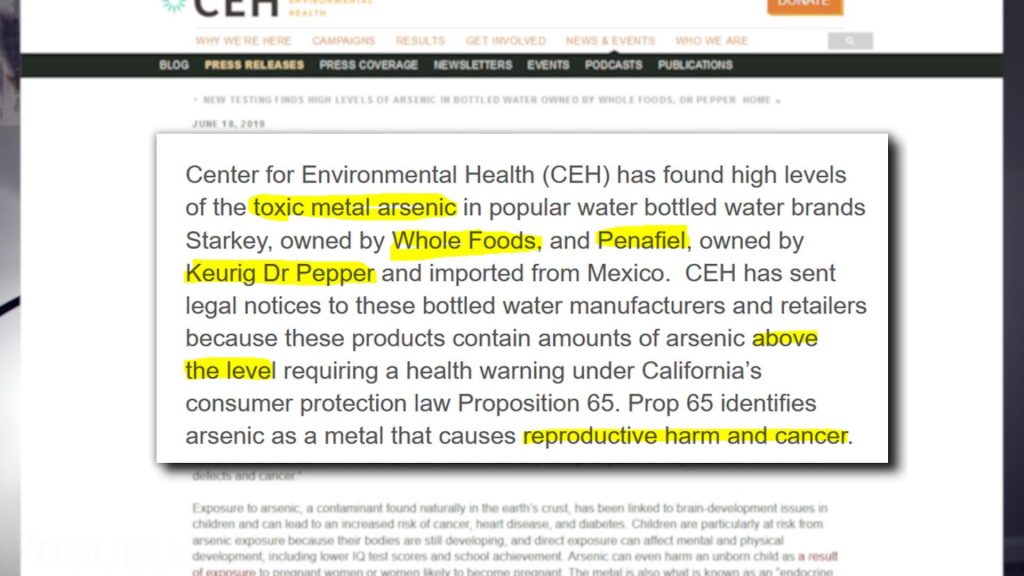
Arsenic, by the way, is one of the 10 chemicals the World Health Organization dubs as a major public health concern. Long term exposure to arsenic is well known to can cause cancer and skin lesions.[18]
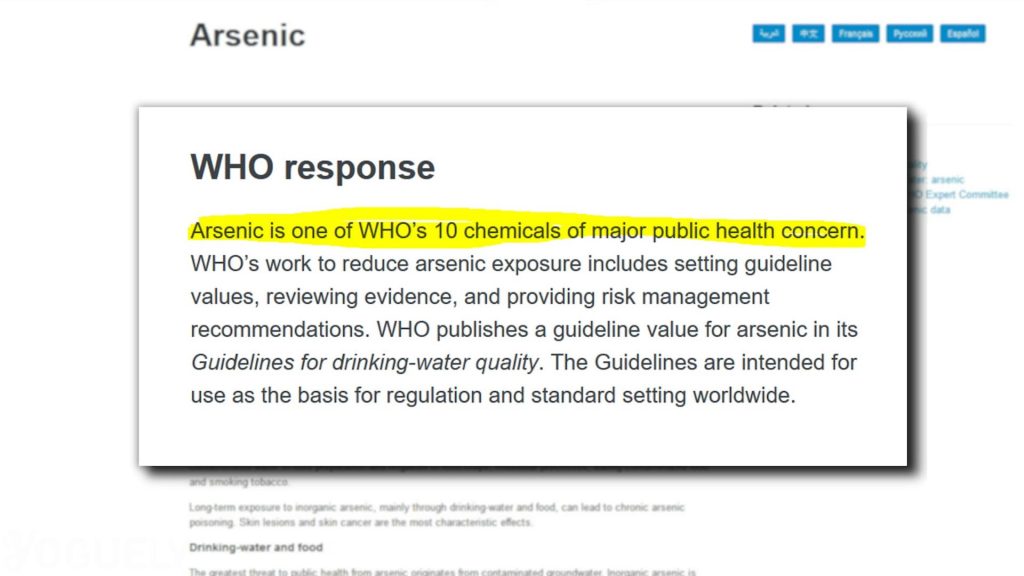
In another instance, the Massachusetts Department of Public Health the Center for Environmental Health (CEH) warned about the presence of PFAS in bottled water sold at Whole Foods and CVS.[19]
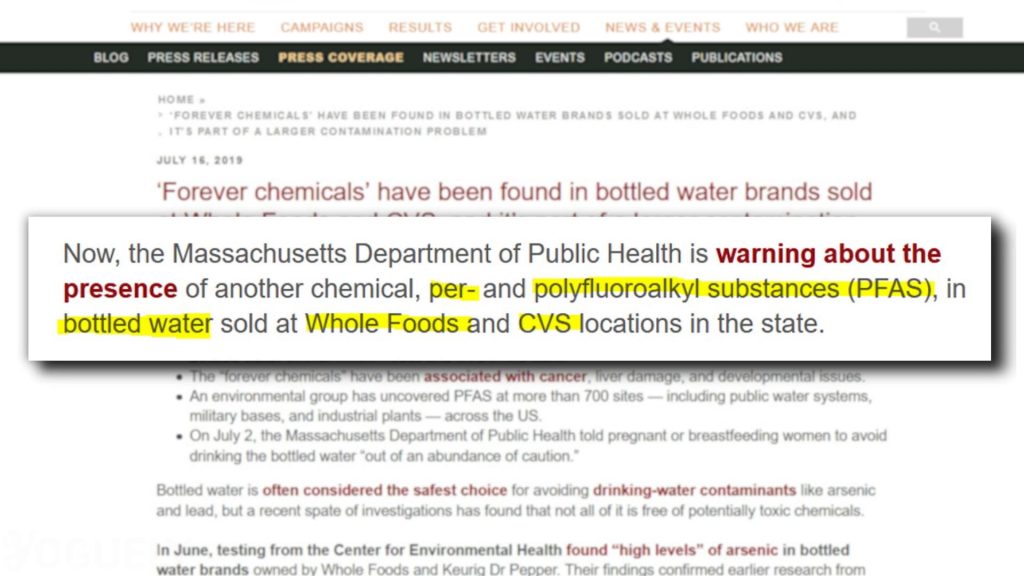
And recall that once you consume PFAS, it persists virtually forever in your body without ever breaking down.
As problem solvers or professional engineers, we are looking for a solution we can trust. So we aim for conservative solutions.
Not conservative in the traditional sense that we’ll “stick to the old ways” and use some archaic method. Instead conservative in the sense that we will that error well on the safe side.
In essence, looking at the worst-case scenario, consuming bottled water isn’t, if at all, safer than tap.
2. Chemicals in Plastic Bottles Can Leach in Your Drinking Water
BPA, BPS and BPF
Some plastic bottle manufactures use bisphenol-A, commonly known as BPA. This chemical BPA migrates into the water when the water is in contact with the plastic. The concern is that BPA is a reproductive, developmental, and systemic toxicant that is weakly estrogenic.[20]
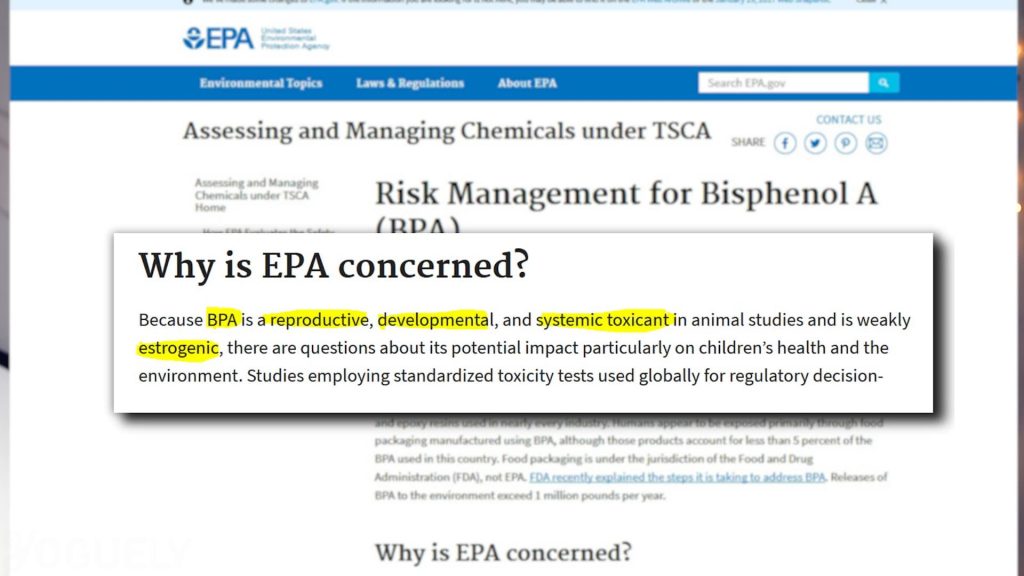
If your careful enough, you can find plastic bottles marketed as BPA-free.
But Polycarbonate clear plastic is made with BPA.
Something smells fishy here. Is it too good to be true?
If a company isn’t using BPA, what are they using? and has it been studied and tested safe?
A substitute to BPA (bisphenol-A), is an unsurprisingly similar chemical called bisphenol-S and bisphenol-F. Scientists have studied both chemicals and concluded both to be unsafe alternatives to BPA.[21]
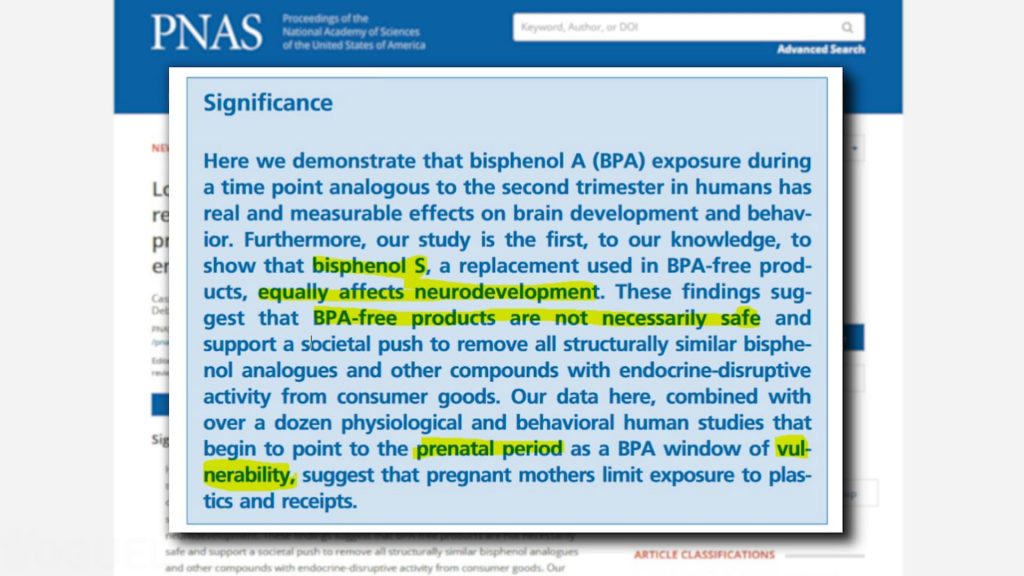
In one study, the finding showed that Bisphenol-S equally affects brain development and behavior, with pregnant mothers being especially vulnerable.[22]
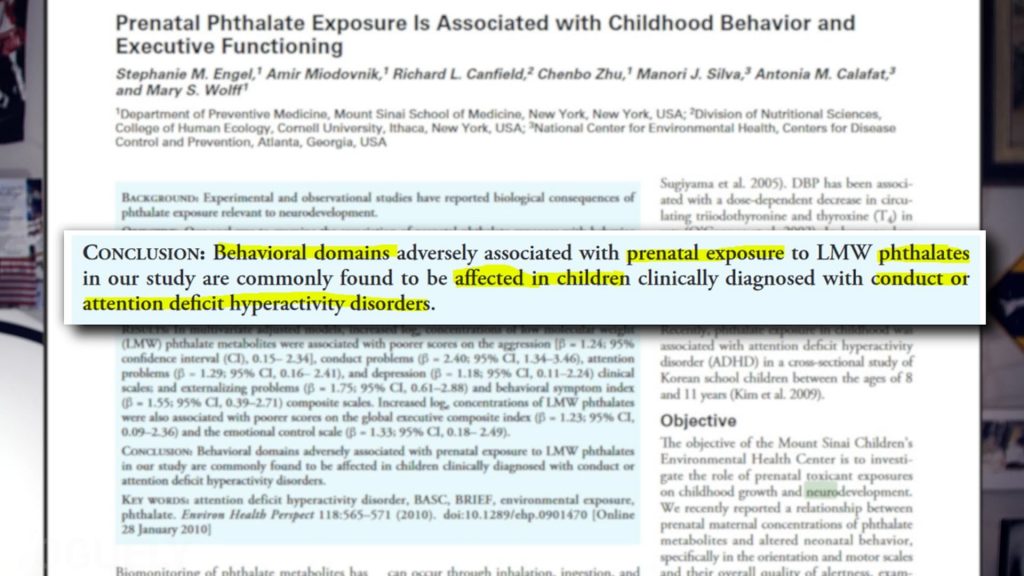
Phthalates
Phthalates are another kind of chemical endocrine disruptor[23] used to manufacture plastic bottles and found in plenty of products, food, and even in humans, which puts us at risk of high exposure to it.[24]
The matter with Phthalates is that they do not strongly bound and easily leach into the water.[25]
Scientists have exposed animals to high doses of phthalates and found that the males resulted having reproductive damage, including infertility.[26] They have also associated phthalates with neurodevelopmental problems in children.[27]
So far, there are no labeling requirements for products with phthalates.[28]
How do you avoid phthalates?
Find products labeled phthalates-free and stray away from plastics marked with recycling code 3.[29]
Polyethylene Terephthalate (PET) Plastics
A different type of plastic material also used to make water bottles is polyethylene terephthalate. Also known as PET plastics, they are easily identifiable by their recycling code marking, a number 1 on bottles.[30]
Studies report that PET bottles leach antimony in to the food they are packaging especially at high temperatures. This kind of situation can happen when you leave your PET water bottle in the car on a hot summer day.[31]
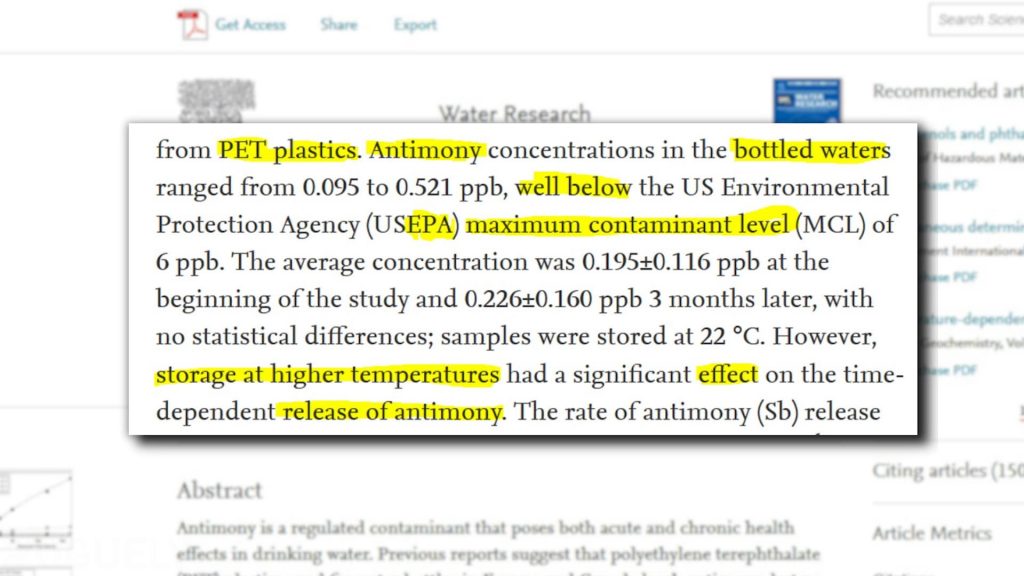
The toxic heavy metal antimony[32] is originally part of antimony trioxide used to make the PET bottles.[33]
At high levels, antimony can cause vomiting and abdominal pain.[33],[34] At the same time, only a minor amount of antimony leaches from PET bottles and the amount falls well below the EPA’s drinking water guidelines.[31]
3. Plastic Water Bottles Are Bad for the Environment
The environmental effects of plastic bottles go back to the very creation of it. Think of the enormous amount of energy that goes into manufacturing a single bottle. That includes human labor, electricity, and machinery.
Then, factor in used up resources like the oil and water used to produce the plastic. It can take up to 7 times the amount of water in the bottle to make the bottle itself![35] In the same fashion, consider the wood manufacturers use to make the paper material for the label.
Finally take into account the gasoline used to transport the bottles to the stores. And the gasoline you spend going to pick up the bottles at the store.
All that driving is generating carbon dioxide, increasing our carbon footprint and contributing to global warming. It’s a chain reaction which will bring serious health problems in the future.
The air pollution affects our lungs. The extreme temperatures can be fatal to our health. Heavy rainfall can carry waterborne diseases. [36]
Tap water on the other hand, doesn’t need fancy packaging or marketing. And it gets to you though an intricate system of water pipes run by municipal power, water pressure and gravity.[37]
Talk about efficiency! It’s brilliant!
Recyclable Plastic Bottles as a Last Resort
You might think “Oh but the bottle is recyclable, and I recycle the 42 water bottles I drink each week!”
Sigh. It’s fantastic that you are recycling. First of all, thank you for that. Nevertheless, the problem is that you are consuming 42 water bottles per week.
As we’ll see later, you can do better than that. I’ll show you how you can drop that down to 0 plastic bottles per week.
The reason you need to recycle plastic in the first place is because most plastic bottles are not designed to be biodegradable. They can stay on Earth for hundreds of years, unable to decompose naturally.[38]
Meanwhile they pose a threat to the ecosystem as animals can get physically harmed by it. Like when an animal gets entangled in plastic.
The chemicals used in the process of manufacturing the plastics are also intoxicating living creatures. One way or another those chemicals eventually end up in the water they drink. [39]
Recycling is actually the last alternative in the hierarchy to reduce waste. [40] The first two, are reduce and reuse. They take priority in order to be truly efficient in reducing our carbon footprint. [41]
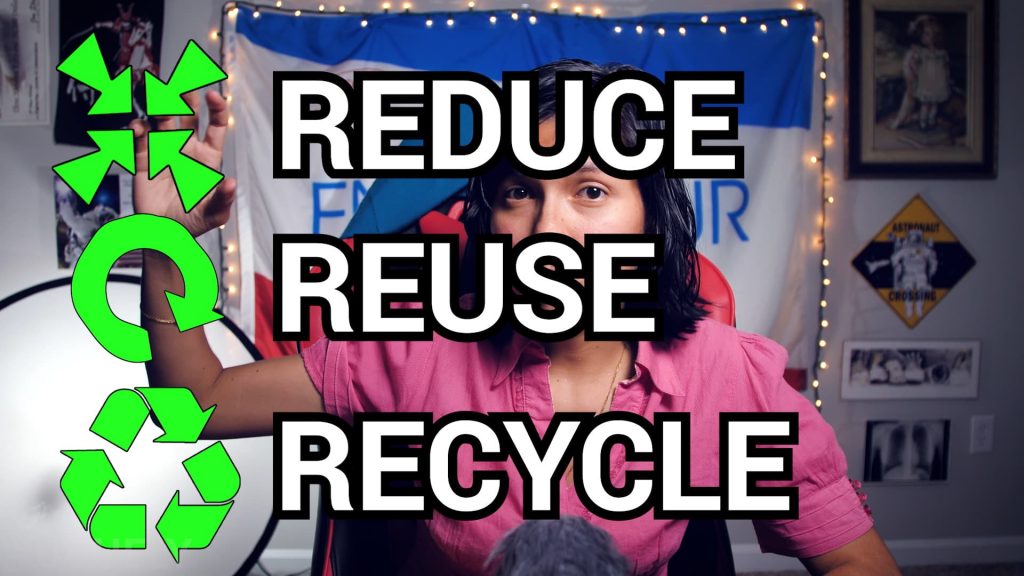
You can accomplish this by reducing the number of bottles you use down to one reusable bottle.
I like this nice stainless steel thermo water bottle (paid link). It has a layer of vacuum insulation which keeps my drinks hot or cold for the whole day.

Mine has taken quite the beating as I take it everywhere with me. I’ve had it with me for almost half a dozen years now and it is still going strong.
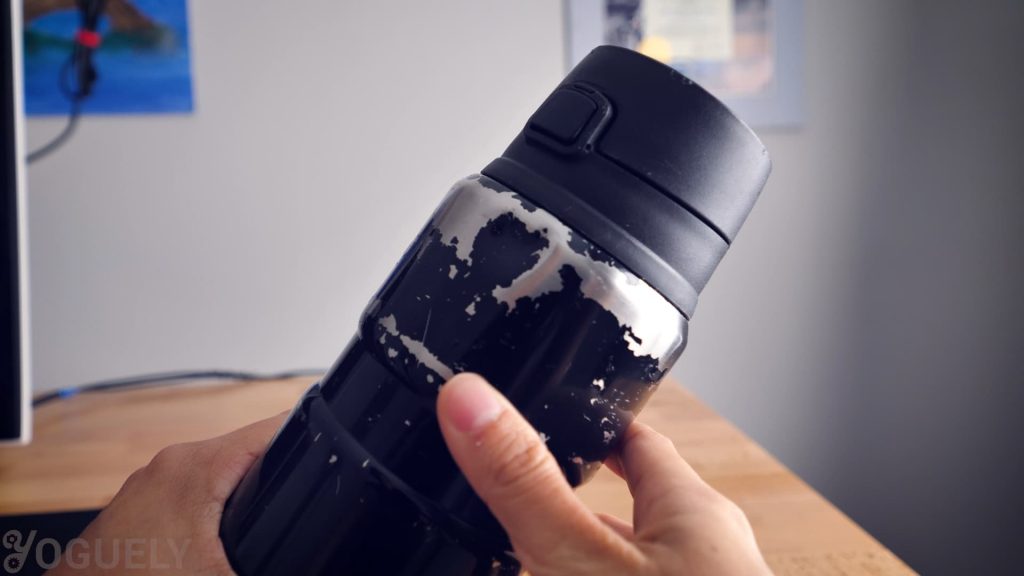
The Alternative to Bottled Water
Here at Yoguely we want efficient solutions that minimize potential harm to living creatures and planet Earth. So, we can confidently discard bottled water as a solution.
A solution that would ensure you are getting pure water is to use a self-serve station at your local grocery store.
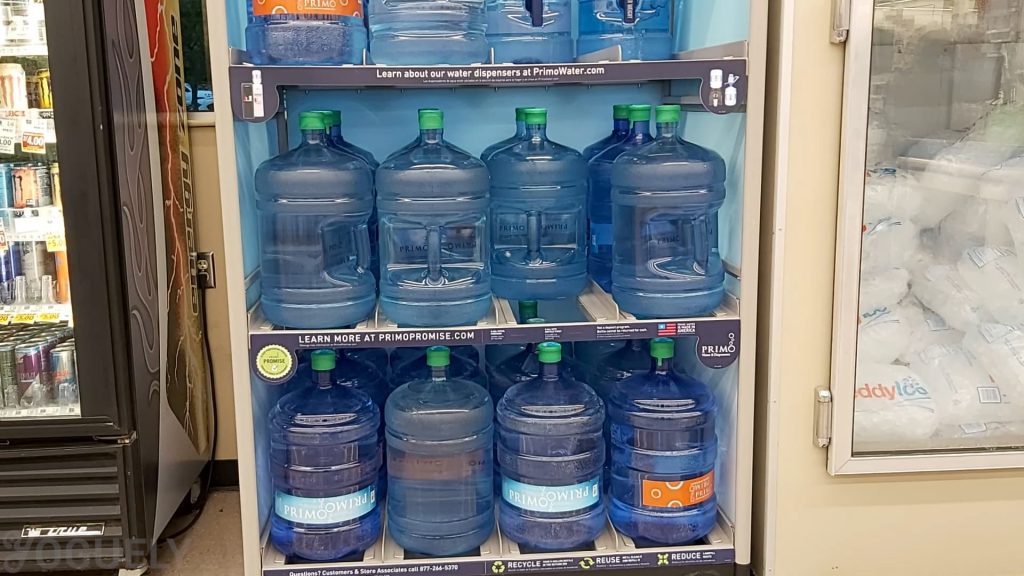
But first! Test the TDS of a small sample. If the readings look good, you can fill up one of those huge reusable water jugs with a week’s worth of healthy drinking water. See this BPA Free 5 gallon Water Container Bottle made from PET Plastic (paid link).
Or check out this heavier 5 gallon glass jug (paid link), it’s great in terms of your health but must be transported with care.
Of course, this is still not an efficient solution.
Place the water jug in the trunk. Drive the car to the store. Unload the water jug. Fill up the jug. Load it back in the trunk. Hope to the Flying Spaghetti Monster that the bottle doesn’t burst on the ride home. Haul it back into your home. Magically dump the water from the huge jug into a smaller beverage dispenser without spilling it. And finally take a sip of victory.
It’s not practical! That’s a lot of time, money, and mental energy!
I’ve had personal experience doing this while I was studying in university and it was not fun. Ever since, I’ve been wanting to figure out an easy way to make healthier water at home.
And folks… I’ve found two do-it-yourself (DIY) methods that work GREAT. They are distillation and reverse osmosis. But which one is the slickest water purification method to use as your daily driver? I’ll show you later in the blog.
Now I would love to hear from you: What do you think of bottled water? Or how are you trying to reduce your use of bottled water?
If you have any questions, let me know in the comments below. Or join the discussion in the Yoguely Community Forum.
I’m Aida Yoguely. Thanks for learning with me today. See you in the next post.
To stay tuned, join our newsletter and get the latest content straight to your inbox.
Video
Be sure to subscribe and hit the notification bell to stay tuned for the latest videos.
References
13. ^ “FDA Regulates the Safety of Bottled Water Beverages Including Flavored Water and Nutrient-Added Water Beverages”. Food and Drug Administration. (2018, September 22). Retrieved 12 September 2019.
14. ^ “Bottled Water and Tap Water – Just the Facts: A Comparison of Regulatory Requirements for Quality and Monitoring of Drinking Water in the United States”. Drinking Water Research Foundation. Retrieved 12 September 2019.
15. ^ Boesler, M. (2013, July 12) “Bottled Water Costs 2000 Times As Much As Tap Water”. Business Insider. Retrieved 12 September 2019.
16. ^ “Water Health Series – Bottled Water Basics”. United States Environmental Protection Agency. (2005, September). Retrieved 12 September 2019.
17. ^ Debczak, M. (2019, June 21). “High Levels of Arsenic Found in Bottled Water From Whole Foods and Dr Pepper”. Metal Floss. Retrieved 12 September 2019.
18. ^ “Arsenic” . World Health Organization. (2018, February 15). Retrieved 12 September 2019.
19. ^ Bendix, A. (2019, July 16) “‘Forever chemicals’ have been found in bottled water brands sold at Whole Foods and CVS, and it’s part of a larger contamination problem”. Center for Environmental Health. Retrieved 12 September 2019.
20. ^ “Assessing and Managing Chemicals under TSCA – Risk Management for Bisphenol A (BPA)”. United States Environmental Protection Agency. Retrieved 12 September 2019.
21. ^ Eladak, S., Grisin, T., Moison, D., Guerquin, M. J., N’Tumba-Byn, T., Pozzi-Gaudin, S., … & Habert, R. (2015). A new chapter in the bisphenol A story: bisphenol S and bisphenol F are not safe alternatives to this compound.. Fertility and sterility, 103(1), 11-21.
22. ^ Kinch, C. D., Ibhazehiebo, K., Jeong, J. H., Habibi, H. R., & Kurrasch, D. M. (2015). Low-dose exposure to bisphenol A and replacement bisphenol S induces precocious hypothalamic neurogenesis in embryonic zebrafish. Proceedings of the National Academy of Sciences, 112(5), 1475-1480.
23. ^ https://www.niehs.nih.gov/health/topics/agents/endocrine/index.cfm National Institute of Environmental Health Sciences. Retrieved 12 September 2019.
24. ^ “Assessing and Managing Chemicals under TSCA – Risk Management for Phthalates”. United States Environmental Protection Agency. Retrieved 12 September 2019. Retrieved 12 September 2019.
25. ^ “Biomonitoring | Phthalates”. United States Environmental Protection Agency. (2017, August). Retrieved 12 September 2019. From America’s Children and the Environment | Third Edition.
26. ^ National Research Council. (2009). Phthalates and cumulative risk assessment: the tasks ahead. National Academies Press.
27. ^ Engel, S. M., Miodovnik, A., Canfield, R. L., Zhu, C., Silva, M. J., Calafat, A. M., & Wolff, M. S. (2010). Prenatal phthalate exposure is associated with childhood behavior and executive functioning. Environmental health perspectives, 118(4), 565-571.
28. ^ “Phthalate”. Wikipedia. Retrieved 12 September 2019.
29. ^ “Phthalates”. National Institute of Environmental Health Sciences. Retrieved 12 September 2019.
30. ^ “PET bottle recycling”. Wikipedia. Retrieved 12 September 2019.
31. ^ Westerhoff, P., Prapaipong, P., Shock, E., & Hillaireau, A. (2008). Antimony leaching from polyethylene terephthalate (PET) plastic used for bottled drinking water. Water Research, 42(3), 551-556.
32. ^ “Toxic Heavy Metal”. Wikipedia. Retrieved 12 September 2019.
33. ^ “Public Health Statement for Antimony”. Centers for Disease Control and Prevention. (2015, January 21). Retrieved 12 September 2019.
34. ^ Cooper, R. G., & Harrison, A. P. (2009). The exposure to and health effects of antimony. Indian journal of occupational and environmental medicine, 13(1), 3.
35. ^ Gustafson, T. (2013, October 30) “How Much Water Actually Goes Into Making A Bottle Of Water”. National Public Radio. Retrieved 12 September 2019.
36. ^ “Climate Effects on Health”. (2019, September 9) Centers for Disease Control and Prevention. Retrieved 12 September 2019.
37. ^ Van Nuck, R. (2018, March 25) “If the Power Goes Out Will I Still Have Water?”. Home Battery Bank. Retrieved 12 September 2019.
38. ^ “Trash-Free Waters – Frequently Asked Questions about Plastic Recycling and Composting”. United States Environmental Protection Agency. Retrieved 12 September 2019.
39. ^ “Trash-Free Waters – Toxicological Threats of Plastic”. United States Environmental Protection Agency. Retrieved 12 September 2019.
40. ^ “Reduce, Reuse, Recycle”. United States Environmental Protection Agency. Retrieved 12 September 2019.
41. ^ Rinkesh. “The ‘Reduce, Reuse, Recycle’ Waste Hierarchy”. Conserve Energy Future. Retrieved 12 September 2019.
42. ^ Felton, R. (2020, June 24). “High levels of arsenic found in US Whole Foods’ bottled water brand”. The Guardian. Retrieved 24 June 2020.
- Why Helicopter Money Is Inflationary - 2021-10-09
- How Interest Rates Affect Inflation - 2021-10-08
- How Long Has Inflation Existed? - 2021-10-01
